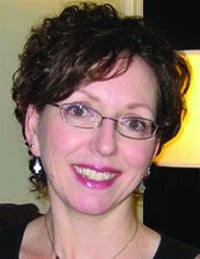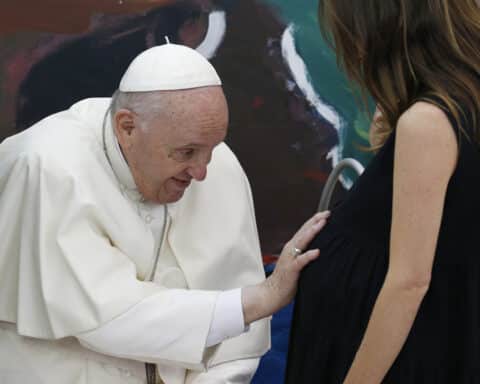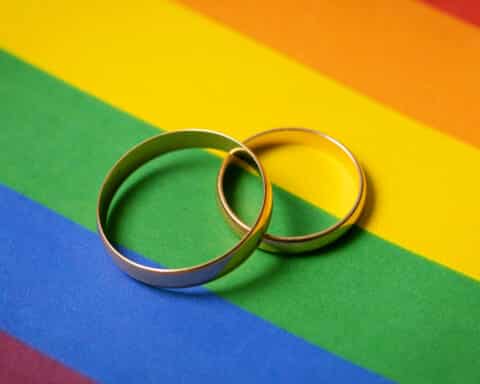So much of what the Catholic Church teaches is taken out of context by a secular society that just doesn’t “get” the big faith picture or by other religious denominations that oppose many of our beliefs and practices.
If you’re Catholic, then you’ve probably been on the receiving end of some of those misstatements meant to make you doubt your faith, at best, or leave your faith, at worst.
Today we’re going to debunk the myths. We’ll look at the most common falsehoods that are thrown around by those who don’t really understand what the Catholic Church teaches and why.
Mary DeTurris Poust writes from New York.
Buying annulments
Myth: If you have enough money and know the right people, you can buy an annulment.
Reality: No matter where you live or who you know, you still have to apply for — and wait for — an annulment if you want the Church to declare a marriage “null,” meaning that something prevented it from being the sacramental covenant God intended it to be.
All dioceses charge a fee for the annulment process, although no one is prevented from petitioning for an annulment due to the inability to pay. Fees and schedules may vary according to geography, caseload, staffing. It is a process that requires a lot of paperwork, judges, advocates, hearings and more. Even the slightest glitch — like an ex-spouse unwilling to cooperate — can turn a simple procedure into a lengthy ordeal. Annulments are not for sale, are not guaranteed, and are not as prying or as painful as the rumor mill purports them to be.
Cross vs. crucifix
Myth: Wearing or displaying a crucifix is idolatrous and a sign that Catholics want to focus only on Jesus hanging on a cross and not on his resurrection.
Reality: Yes, Catholics prefer a crucifix over an empty cross, but not for the reasons many evangelical Protestants and others suspect. Catholics see victory in the cross. It was through Jesus’ suffering that we are saved. Why would we want to pretend his suffering never happened? The resurrection could not come about without the crucifixion; the two are eternally linked. For Catholics, the crucifix is not something to idolize or something to look at in fear. It is a sorrowful reminder that our God died for our sins and then rose from the dead, opening the gates of heaven. Catholics know that Jesus is risen, something we celebrate at every Mass, but the suffering of the crucifixion can never become a footnote to the glory of the Resurrection.
Indulgences
Myth : Catholics can buy forgiveness, or buy their way out of hell, with indulgences.
Reality: Indulgences have a terrible reputation in non-Catholic circles and, sadly, even in some Catholic circles due to abuses back in the days of Martin Luther when almsgiving and the granting of indulgences were tied together. But here’s the truth about indulgences: they cannot get you out of hell once you are there. They can only reduce the “temporal punishment” due to you for the sins you committed. In other words, an indulgence, which you can receive through reconciliation or particular prayers or actions, can get you the equivalent of time served in purgatory. And, if you offer particular prayers or actions on behalf of someone else, you can reduce their punishment as well. Still, only the Sacrament of Reconciliation can save you from eternal punishment. Indulgences just chip away at the just rewards you will receive in the next life for the sins you committed in this one.
Mary worship
Myth: Catholics worship Mary when they should worship God alone.
Reality: Catholics do not worship Mary. We honor Mary, but we do not adore her. Worship and adoration are reserved for God alone.
However, Mary, without a doubt, holds a critical place in the life of a Catholic.
Mary, through her fiat, became a collaborator in God’s plan for salvation. She was chosen to conceive Jesus Christ and agreed despite her fears and confusion. She gave birth to and nurtured, taught and loved God’s only son. Her child is both fully human and fully divine, making her the Mother of God.
Protestants and non-Christians often confuse Catholic devotion to Mary. They say the Bible does not instruct Christians to honor Mary in such a way, and they take issue with our description of Mary as Mother of God.
Let’s go back to the scene of the Visitation in the first chapter of Luke’s Gospel, where we can address both arguments: “When Elizabeth heard Mary’s greeting, the infant leaped in her womb, and Elizabeth, filled with the holy Spirit, cried out in a loud voice and said: ‘Most blessed are you among women, and blessed is the fruit of your womb. And how does this happen to me, that the mother of my Lord should come to me?” (Lk 1:41-43 )
And Mary responds: “Behold, from now on will all ages call me blessed” (Lk 1:48 ).
So there we have Mary addressed as the Mother of God and Mary held up as someone who should be considered blessed by all future generations.
The Catechism of the Catholic Church explains that Mary has a continued role in the life of the Church that is “inseparable from her union with Christ and flows directly from it” (No. 964 ).
Catholics see Mary as their spiritual mother and go to her for comfort and assistance. When we pray for Mary to intercede for us, we are not asking Mary to grant our request. We are praying that the Blessed Mother will take our prayer needs to her Son on our behalf.
And who better to trust with those intentions? After all, it was at his mother’s request that Jesus performed his first miracle at the wedding at Cana.
The statues, the medals, the stained-glass windows and the prayer cards depicting Mary are not a sign of worship but a sign that Catholics recognize Mary’s role in helping them move closer to her Son, which is supposed to be the ultimate goal for every Christian.
“To Jesus through Mary,” the old devotion says, explaining in a few simple words what this somewhat complicated relationship with Mary is all about.
Save yourself
Myth: Catholics think they can accomplish their own salvation through good works.
Reality: Faith alone versus faith combined with good works is a debate that is probably most closely associated with Martin Luther, but the truth is that this argument was evident from the earliest days of the Church.
Go back to the New Testament, the letters of James and John in particular, and it becomes clear that, even then, some people tried to insist that faith alone was enough to guarantee salvation. But the Church teaches that it is faith in Jesus Christ expressed through love for others that is the path to salvation. And that makes sense, doesn’t it? If we are to love one another as God loves us, then we must allow that love to permeate our lives and affect the things we say and do.
In James 2:14-17 , we read the classic scriptural reference to this point: “What good is it, my brothers, if someone says he has faith but does not have works? Can that faith save him? If a brother or sister has nothing to wear and has no food for the day, and one of you says to them, ‘Go in peace, keep warm, and eat well,’ but you do not give them the necessities of the body, what good is it? So also faith of itself, if it does not have works, is dead.”
For a more modern take on this, let’s turn to Deus Caritas Est (“God Is Love”), the first encyclical by Pope Benedict XVI: “Love of neighbor, grounded in the love of God, is first and foremost a responsibility for each individual member of the faithful, but it is also a responsibility for the entire ecclesial community at every level. … As a community, the Church must practice love. Love needs to be organized if it is to be an ordered service to the community,” the pope wrote, saying that the Church’s “deepest nature” is expressed through proclaiming the word, celebrating the sacraments and exercising the “ministry of charity” (No. 20).
The bottom line is that love of God and love of neighbor, as Jesus outlined in the greatest commandment, does not ring true if it does not go beyond the individual believer. It must find its expression in the very things that Jesus preached during his lifetime — feeding the hungry, comforting the lonely, clothing the naked. Faith alone is not enough. Nor are good works alone enough. Catholics believe that true faith in Jesus Christ naturally leads to actions on behalf of others, and those two things in tandem lead to salvation.
Anti-sex attitudes
Myth: The Catholic Church is opposed to sex and to sexuality and sees it only as a means of producing children.
Reality: As they say in advertising, “sex sells,” and that’s bad news for a Church that sees sex as something that is properly a sacred action between a husband and wife and not simply some animal urge to be satisfied or exploited. Right off the bat, the Church is at a disadvantage in getting society to appreciate its teaching on this subject. First of all, we have to understand that there is a big difference between sex and sexuality. Sex is an act, and there are times when that act is acceptable according to Church teachings and times when it is not. Sexuality, on the other hand, is not just about sexual desires but about sexual identity — all of the qualities that define a person as a man or woman. The Church, in discussing sexuality, wants to look at the whole person, not just physical desires.
Within that framework, the Church promotes chastity, another term that often gets mistaken for something it’s not. Chastity is not another word for celibacy. It is not about abstaining from sex; it’s about the right living out of your sexuality according to your vocation. Yes, if you are a priest, Religious or single person, then chastity will mean you are not sexually active. But even married couples are expected to live chaste lives through the ways they treat their spouses and respect the beauty and wonder of sex within their sacramental relationship.
Here’s a quote from the Catechism of the Catholic Church that should shake up the misperception of the Church as anti-sex and anti-physical love: “In marriage, the physical intimacy of the spouses becomes a sign and pledge of spiritual communion” (No. 2360 ). So the Church not only approves of sex — when it is part of a sacramental marriage open to procreation — but it says that a couple’s physical union is taken to a spiritual level through their intimacy. Hardly a prudish thought; in fact, it’s somewhat poetic.
In our free-love society, it is often difficult for people to separate the out-of-context headlines or stories they hear about Church teaching on sex and sexuality from the reality of that teaching. Because our culture insists, “If it feels good, do it,” it’s a hard sell when the Church says: “Wait. Save this deeply spiritual and meaningful bond for marriage.” The Church is not anti-sex. The Church is pro-sex, within the context of a marriage between a man and a woman.
Oppressing women
Myth: The Catholic Church is anti-woman, as evidenced by the all-male priesthood and the ban on artificial birth control.
Reality: Actually the Catholic Church holds women in high esteem. After all, Catholics believe that God was born of a woman, an extraordinary woman, true, but a woman nonetheless. It seems many people can’t get past the Church’s all-male priesthood when it comes to this issue. The idea that there is something a woman cannot do equals oppression in some people’s minds. However, we have to go back to the larger Church teaching, as is usually the case, to separate the headlines from the real story.
Let’s dispense with the women’s ordination problem right off the bat. The Church teaches that today’s bishops are the successors of the original Twelve Apostles, who were handpicked by Jesus Christ. Because Jesus did not choose any women, the Church says that it is bound to do as Jesus did, that it has no authority to ordain women. Some will argue that it was just a factor of Jesus’ time in history, but, remember, Jesus didn’t stick to societal norms in other instances — eating with tax collectors, talking to the Samaritan woman at the well, appearing first to a woman after his resurrection — so it’s unlikely that if Jesus wanted a woman among the Twelve that he would have let conventions stop him.
The lack of women priests, however, has not kept women from having positions of power within the Church. Throughout history, women have served in formative and critical roles. They founded religious orders and hospitals, established schools and headed universities, and today more women than ever before — both Religious sisters and laywomen — are in administrative positions on both parish and diocesan levels.
Another part of the anti-woman claim is caught up in the fact that the Church is opposed to artificial birth control. Secular society, women in particular, often misinterpret that ban to mean that the Church wants women to have babies in endless succession. It’s the old barefoot-and-pregnant mind-set. People think that the Church’s pro-life position amounts to an anti-woman attitude.
The Church’s stands on birth control and abortion are not about keeping women down but about protecting and preserving the sanctity of life and the sacredness of marriage and procreation. Church teaching says that married couples must be open to new life, but it does not say that you must have as many children as your body can bear. In fact, the Church, in the Catechism, teaches that parents may space their children in a responsible way — that is, not for selfish reasons like wanting to take more vacations or have more disposable income. And to do that spacing, Catholic couples are told to use methods — such as natural fam-ily planning — that rely on occasional abstinence and do not interfere with or obstruct the possibility for procreation during sexual intercourse.
Again, looking at the woman “issue” as separate from the Church’s larger teaching makes it easier to target it as oppression. But when you view the Church’s positions on the all-male priesthood or on artificial birth control as part of an overarching teaching that always goes back to Scripture and to an interpretation of Jesus’ own teachings, it becomes clear that these often controversial points are about upholding Tradition and protecting the sanctity of life and the dignity of all people, born and unborn.
Replacing God
Myth: Catholics put the pope, bishops and priests in the place of God.
Reality: The pope, bishops and priests are representatives of Christ on earth but do not take his place in the minds and hearts of his people. When a priest celebrates Mass or grants absolution during confession, he is said to be acting in persona Christi , in the person of Christ. Everything revolves around Christ, and nothing about ordination makes a human divine. The Catechism of the Catholic Church explains that holy orders “confers a gift of the Holy Spirit that permits the exercise of ‘sacred power,’ which can come only from Christ himself through his Church” (No. 1538). In other words, through the power of the Spirit, ordinary men are given the grace and power to act in the person of Christ. St. Thomas Aquinas put it like this: “Only Christ is the true priest, the others being only his ministers.”
Pagan-style practices
Myth: Catholicism is no better than paganism.
Reality: People who don’t know their facts see Catholics wearing religious medals or praying with rosary beads, see statues with candles burning before them or incense rising from the altar and think, as one anti-Catholic website puts it, that Catholicism is nothing more than “paganism clothed in Christian veneer.” Many of the things that non-Catholics think of as “pagan” are in reality sacramentals and devotions designed to help us humans make a connection to the Divine. They have nothing to do with idol worship or magic and everything to do with growing in faith. Put it this way, it’s a pretty big leap from earth to heaven; having sacred signs — holy water, relics, stained-glass windows — open the door a bit to the graces we receive through the sacraments themselves. Sacramentals are add-ons. The beads and candles, flowers and holy vessels are not the focus of faith but the things that give us physical ways to express our faith, deepen our faith and live our faith day by day.
Piles of gold
Myth: The Roman Catholic Church is the richest organization in the world and should sell off its treasures to feed the poor.
Reality: Despite what you hear and read, there are no piles of gold littering the Vatican. Yes, there are artistic, historic and cultural treasures at the Vatican and scattered throughout the universal Church. However, the Church views itself as the preserver of those treasures, not as an owner who can trade or sell its valuable wares. If the treasures were sold off to feed the poor or serve the needy in some other way, they would fall into the hands of private owners, who would not necessarily make them available to the public or preserve them for future generations. And the poor would still need to be fed. The Church is the dutiful caretaker of its treasures, not an auctioneer waiting for the highest bidder.
Opposition to reason
Myth: Catholics cannot accept the findings of science or reason.
Reality: In the opening paragraph of his 1998 encyclical letter, Fides et Ratio (“Faith and Reason”), Pope John Paul II said this: “Faith and reason are like two wings on which the human spirit rises to the contemplation of truth.”
And lest we think this idea is something that came up only in recent Church writings, let’s go back to 1879, when Pope Leo XIII, in his encyclical Aeterni Patris (“Of the Eternal Father”), said that “advantage should be taken of human science,” which he called an “approved and wise practice which history testifies was observed by the most illustrious Fathers of the Church.
“They, indeed, were wont neither to belittle nor undervalue the part that reason had to play, as is summed up by the great Augustine when he attributes to this science ‘that by which the most wholesome faith is begotten … is nourished, defended, and made strong'” (No. 3). That’s Pope Leo quoting St. Augustine, who was talking about faith and reason back in the fourth century.
So with that kind of history, how is it that Catholics are portrayed as people of blind faith with the intellectual curiosity of strained peas? Probably because the secular media and secular society in general choose not to look below the surface of Catholic teaching, Catholic history and the lives of Catholic saints and leaders — all of which disprove the theory that you cannot be an intellectual heavy-weight and a true believer at the same time. Throughout history (controversies like the Galileo case aside) the Church has supported scientific study. In fact, the Vatican Observatory is one of the oldest astronomical research institutes in the world.
But even many Catholics have been convinced that their faith is incompatible with certain scientific findings. Catholics have bought into the notion that just because the Church disagrees with some scientific efforts or findings on moral or ethical grounds, such as destructive embryo research, that it means it is opposed to science. The Catechism of the Catholic Church stresses that science and technology are “precious resources” and that scientific research is a “significant expression of man’s dominion over creation” (No. 2293). So the Church is not opposed to science or reason, but it views those things in light of how they serve humanity and human dignity.
Another charge you often hear is that the Church rejects the theory of evolution. So let’s set the record straight on a few things: Catholics are not obliged to believe in the literal interpretation of the Genesis story and Adam and Eve to explain the beginning of the universe or the creation of humankind. Catholics can believe that the world was created by a “big bang,” but not a random big bang. If there was a big bang, it was God who set it in motion.
Catholics can believe in evolution, but not in strict Darwinism. Why? Again it comes down to the fact that Darwinism theorizes that human evolution came about through random selection. Yes, humans could have evolved over time, according to God’s greater plan, but there was nothing random about it.
No chapter and verse
Myth: The Catholic faith is not a Bible-based faith.
Reality: Let’s be honest, many Catholics cannot go around quoting various Scripture passages by chapter and verse. However, most Catholics do know the Bible accounts that serve as the foundation of the faith they profess. After all, we hear the readings from the Old Testament and New Testament in a repeating cycle at Mass every week, every day. We listen to the words of Jesus during the consecration and repeat the words of Jesus when we pray the Our Father. Catholics are certainly no strangers to Scripture.
The Catholic faith does not start with Jesus and his teachings but with the beginning of all time. Catholics trace our past through the Old Testament, watching God’s plan unfold bit by bit until it culminates in Jesus Christ in the New Testament. First God reveals himself through the prophets and the Law; later he reveals himself through Jesus Christ and the Holy Spirit. The Catholic Church begins with that revelation in Scripture, but it does not end with Scripture. The living faith that is based in Scripture and is handed on from generation to generation, first by the apostles and later their successors, the bishops, is known as “apostolic tradition.”
The Church teaches that Scripture and Tradition (with a capital “T”) cannot be separated. They both flow from Jesus — the written word and the living Word. The magisterium provides authentic interpretation of both Scripture and Tradition, becoming the third and final piece of this Bible-based cornerstone. The Catechism of the Catholic Church states that sacred Scripture, sacred Tradition and the teaching of the magisterium are “so connected and associated that one of them cannot stand without the others. Working together, each in its own way, under the action of the one Holy Spirit, they all contribute effectively to the salvation of souls” (No. 95) .
Scripture is ever present in every aspect of the Catholic faith — from the daily prayers Catholics say at home, to the prayers and readings at Mass, to the Liturgy of the Hours, or Divine Office, which uses Psalms, hymns, prayers and Scripture passages to mark the rhythm of each day.
Pope Joan
Myth: Pope Joan concealed her gender and served as pope for almost three years in the 850s, but the Church erased all records to hide the fact.
Reality: If you put the legendary Pope Joan’s name into a Google search, you will find all sorts of interesting theories, but the fact remains that this story is just a fairy tale. Rumors about Pope Joan began to surface in the mid-13th century. Experts say the story started with a Roman folk tale, which was embellished over time.
Today Pope Joan is almost universally regarded as fictitious — except by those who have something to gain by promoting a make-believe female pope. Accounts of the Pope Joan story differ in detail, with some claiming she served in the 850s, succeeding Pope Leo IV, and others claiming she succeeded Pope Victor III, who died in 1087. Quite a swing in dates. If you look at the popes and the years and the claims, they just don’t fit. There’s no room for a Pope Joan in the time line.
Infallibility
Myth: Catholics believe that the pope cannot sin and can never be wrong.
Reality: Infallibility can get complicated. It does not refer to an inability to sin. It does not refer to some sort of magical mumbo jumbo that makes the pope’s words irrefutable. In fact, no human being can be completely infallible; only God is infallible. The pope exercises infallibility when he applies the gift of the Holy Spirit to the Church’s teachings on faith and morals. Not only does the pope exercise infallibility, but, the Second Vatican Council recognized that bishops, when acting in unity with the pope, also may exercise infallibility, either in their own dioceses when promulgating a teaching on faith or morals, or when the bishops act together as part of an ecumenical council. Within the category of infallibility, theologians talk about two classifications: “primary” objects and “secondary” objects. Primary objects of infallibility include anything regarding Church teaching that is revealed by God and pertains to salvation, such as the declaration in 1950 that Mary’s assumption into heaven is an article of faith. Secondary objects of infallibility would include things like canonizations or approval of religious orders.





